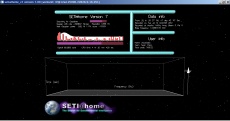“SETI@home”的版本间差异
小 |
小 (→'''项目成果''') |
||
| 第39行: | 第39行: | ||
=='''项目成果'''== | =='''项目成果'''== | ||
| + | While the project has not detected any ETI signals (see extraterrestrial intelligence), it has identified several candidate targets (sky positions), where the spike in intensity is not easily explained as noisespots, for further analysis. The most significant candidate signal to date was announced on September 1, 2004, named Radio source SHGb02+14a. | ||
| + | |||
| + | Astronomer Seth Shostak has stated in 2004 that he expects to get a conclusive signal and proof of alien contact between 2020 and 2025, based on the Drake equation. This implies that a prolonged effort may | ||
| + | benefit SETI@home, despite its (present) nearly ten-year run without success in ETI detection. | ||
| + | |||
| + | |||
| + | While the project hasn't reached the goal of finding extraterrestrial intelligence, it has proved to the scientific community that distributed computing projects using Internet-connected computers can succeed as a viable analysis tool, and even beat the largest supercomputers. However, it has not been demonstrated that the order of magnitude excess in computers used, many outside the home (the original intent was to use 50,000-100,000 "home" computers), has benefited the project scientifically. (For more on this, see 'threats to project' below.) | ||
=='''未来计划'''== | =='''未来计划'''== | ||
2009年10月16日 (五) 22:16的版本
|
SETI@home | |
|---|---|
| 文件:SaH logo.gif SETI@home logo | |
 Multi-Beam 任务的运行界面 | |
| 开发者 | 加利福尼亚州大学伯克利分校,空间科学实验室 |
| 版本历史 | 1999年5月17日 以独立运算平台公开运行,对独立平台的计算程序称为 SETI@home Classic 。 2005年8月27日 开启基于 BOINC 平台的计算程序。 2005年12月15日 结束独立运算平台的 SETI@home Classic。 2006年5月3日 开始新程序版本并运算新任务的 SETI@home Enhanced,该程序于2007年8月更名为 Multi-Beam。 2008年7月中旬 融入 Astropulse 计算任务。 2008年12月18日 开始支持 CUDA 的 GPU 计算程序,运行 Multi-Beam 任务。 |
| 运算平台 | Windows/Linux/Mac |
| 项目平台 | BOINC |
| 程序情况 | |
| 任务情况 | Multibeam子项目每个任务文件256KB,限期7日。 Astropulse子项目每个任务文件8,192KB,限期30日。 |
| 项目状态 | 运行中/开放注册 |
| 项目类别 | 物理与天文学 |
| 优化程序 | SETI@home:优化程序 |
| 计算特点 | CPU密集: |
| 官方网址 | SETI@home |
| [{{{rss}}} 通过 RSS 获取项目新闻] | |
SETI@home(Search for ExtraTerrestrial Intelligence at Home,在家搜寻外星智慧(地外文明---也就是我们常说的“外星人”)),是一个通过互联网利用家用个人计算机处理天文数据的分布式计算项目。该项目试图通过分析阿雷西博射电望远镜采集的无线电信号,搜寻能够证实外星智能生物存在的证据。该项目由美国加州大学伯克利分校的空间科学实验室主办。
科学研究
SETI@home 的原始目标有两个,第一个是要证明分布式计算概念的可行性和实用性。第二个是本身SETI的有益科学研究,以科学方法分析、探索地球以外的智慧生命。
其中第一个目标已经被普遍认为是完全成功的。由 SETI@home 发展开始到现在的 BOINC 环境,在广泛的科研领域支持了大量计算密集型的项目。
第二个目标至今未能实现:SETI@home 未能找到证明来自地外文明信号的证据。但是,项目仍继续探索,不断更新设备及分析办法来查找信号。
SETI@home 是通过分析来自阿雷西博天文台的射电望远镜收集的数据来寻找地球以外文明生命的证据。它是以“被背负”或者说“被动地”的形式当其他科学项目在利用望远镜的时候顺便获取数据。数据会被数据化存储,并发送到 SETI@home 总部。这些数据会根据频率和时间被分解成小块,通过软件进行分析,从可能含有信息的背景噪音中寻找所有信号。SETI@home 需要把每份数据分解数以百万计的小块,然后发送给家用电脑分析,并让软件返回计算结果。以互联网为基础的社会对这项繁重的数据分析提供了帮助。
计算程序会从搜索以下5种有别于噪声的信号:
- 峰值的谱密度
- 信号能力的高斯上升和下降,这种信号可能表示望远镜的接收器略过一个信号源。
- 三连波信号,连续的三个等距峰值信号。
- 窄带脉冲信号,可能在窄带上的数字信号。
- 广域极短脉冲,覆盖到脉冲星及原生黑洞的信号。详细请查看 Astropulse。
除此以外星际介质和星体的相对运动还会让信号出现很多其他的变化,这些潜在的“信号”会用若干办法进行处理,而 SETI@home 的计算程序也会在一定程度上对这些加工过的数据进行分析。
项目成果
While the project has not detected any ETI signals (see extraterrestrial intelligence), it has identified several candidate targets (sky positions), where the spike in intensity is not easily explained as noisespots, for further analysis. The most significant candidate signal to date was announced on September 1, 2004, named Radio source SHGb02+14a.
Astronomer Seth Shostak has stated in 2004 that he expects to get a conclusive signal and proof of alien contact between 2020 and 2025, based on the Drake equation. This implies that a prolonged effort may
benefit SETI@home, despite its (present) nearly ten-year run without success in ETI detection.
While the project hasn't reached the goal of finding extraterrestrial intelligence, it has proved to the scientific community that distributed computing projects using Internet-connected computers can succeed as a viable analysis tool, and even beat the largest supercomputers. However, it has not been demonstrated that the order of magnitude excess in computers used, many outside the home (the original intent was to use 50,000-100,000 "home" computers), has benefited the project scientifically. (For more on this, see 'threats to project' below.)
未来计划
如何加入项目
该项目基于 BOINC 平台,简要的加入步骤如下(已完成的步骤可直接跳过):
- 下载并安装 BOINC 的客户端软件(官方下载页面或程序下载)
- 点击客户端简易视图下的“Add Project”按钮,或高级视图下菜单中的“工具->加入项目”,将显示向导对话框
- 点击下一步后在项目列表中找到并单击选中 SETI@home 项目(如未显示该项目,则在编辑框中输入项目网址:http://setiathome.berkeley.edu/ ),然后点击下一步
- 输入您可用的电子邮件地址,并设置您在该项目的登录密码(并非您的电子邮件密码)
- 再次点击下一步,如项目服务器工作正常(并且有适合自身操作系统的计算程序),即已成功加入项目
更详细的加入方法说明,请访问 BOINC 新手指南 或 BOINC 使用教程。
本站推荐您加入 Team China 团队,请访问项目官方网站的 团队检索页面,搜索(Search)并进入 Team China 的团队页面,点击页面中的 Join 并输入用户登录信息即可加入!